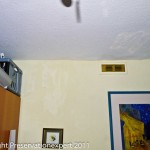I’m finding that the number of enquiries relating to damp stains on chimneys is on the up. The common complaint is that the roofer has either fixed the stack or the flashing, but the damp still comes in. Usually the roofer has been back a couple of times or three and still the problems […]
Damp Diagnosis case study; a bridged DPC in a cavity wall
Having recently posted Graham Coleman’s moisture profile table on Preservationexpert, I thought I’d keep an eye out for some on-site case studies for you, which demonstrate some finer points to take account of on damp surveys. This one is a classic rising damp profile I found the other day, using a conductivity moisture meter, […]
Damp and Timber CPD with ARC Engineers of Leeds

I spent an hour or two with Andrew Rimmington and the engineering staff of ARC engineers, in Morley, Leeds earlier today . Andrew is a keen supporter of continuous professional development and as he said to me today “We don’t do damp and timber surveys, but we need to know what’s involved and what […]
Masonry Water repellents have grown up
Before I begin I should admit that in the past, I’ve been a bit critical of water repellent treatments applied to walls. Penetrating damp is usually more to do with ropy pointing and leaking gutters than porous walls and it’s essential to get these fundamentals right first. Sometimes though, in exposed locations, moisture tracks […]
What the hell do these moisture meter readings actually mean? or, Have I got rising damp or not?

Electrical Moisture meters for damp diagnosis – oh yes. A thing that raises an eyebrow amongst some independent surveyors is the way we so called ‘specialists’ seem happy to diagnose rising damp, or damp of any kind, using nothing more than our eyes and a conductivity moisture meter. “Ha; I can get a reading […]
